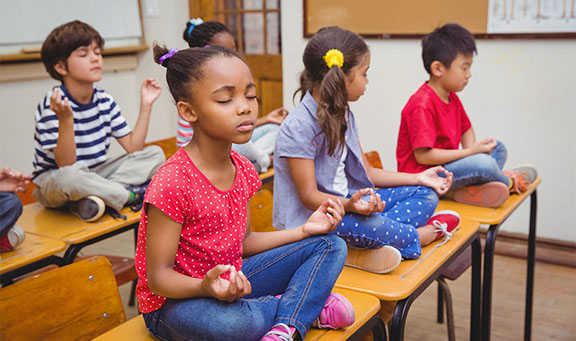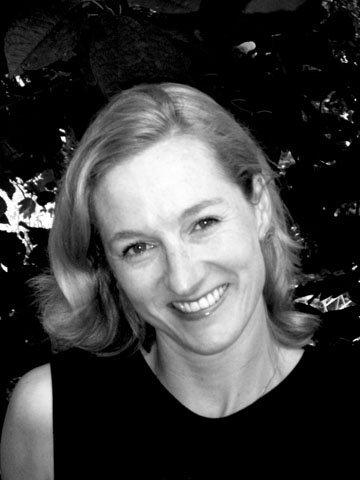 In 2004 Allison Slade became the cofounder and principle of Namaste, a charter school in inner city Chicago that she designed to meet the needs of low-income, high crime neighborhoods. This school takes a holistic approach to education with a focus on the physical, mental and emotional health of the children. A significant part of the school culture is based on the principles of Yoga. The name of the school, Namaste, is a Sanskrit word that translates to “I bow down to the inner divinity within you.” Serving 250 children in grades K-4, students start every day with Yoga classes. Children are taught to notice when they need to wake up or calm down. The popular school has been reviewed in a number of popular magazine’s and has inspired more schools and teachers to begin integrating some of the benefits of Yoga into the school day. The principal of Namaste Allison Slade stated in 2006, “Since opening our doors two years ago, our phones have been literally ringing off the hook with all the requests from educators looking to learn more about our unique approach.” Nationwide, programs like Yoga at School, Yoga Ed, Yoga Kids, Yoga in My School, and Yoga Playgrounds have emerged to train school teachers across the country on ways to integrate Yoga into schools.
In 2004 Allison Slade became the cofounder and principle of Namaste, a charter school in inner city Chicago that she designed to meet the needs of low-income, high crime neighborhoods. This school takes a holistic approach to education with a focus on the physical, mental and emotional health of the children. A significant part of the school culture is based on the principles of Yoga. The name of the school, Namaste, is a Sanskrit word that translates to “I bow down to the inner divinity within you.” Serving 250 children in grades K-4, students start every day with Yoga classes. Children are taught to notice when they need to wake up or calm down. The popular school has been reviewed in a number of popular magazine’s and has inspired more schools and teachers to begin integrating some of the benefits of Yoga into the school day. The principal of Namaste Allison Slade stated in 2006, “Since opening our doors two years ago, our phones have been literally ringing off the hook with all the requests from educators looking to learn more about our unique approach.” Nationwide, programs like Yoga at School, Yoga Ed, Yoga Kids, Yoga in My School, and Yoga Playgrounds have emerged to train school teachers across the country on ways to integrate Yoga into schools.
Despite the increasing popularity of Yoga nationwide, some individuals and families located in Massena, New York, Aspen, Colorado and Raleigh, North Carolina believe that the introduction of Yoga violates the separation of church and state. One of the first recorded complaints regarding Yoga’s inclusion in education is found in a 1992 edition of Education Week where it was reported that “education officials in Michigan…dropped a deep-breathing exercise for students from the statewide health curriculum when some parents linked it with occult practices.” Yoga breathing practices have been linked to decreased stress levels in students, which has encouraged some teachers to integrate breathing practices prior to testing and other stressful events; citing the burgeoning research on the positive effects of breathing practices does little to quell the concerns of those who fear that stress-management is a thin veil for the promotion of “Far Eastern” religions. The Rev. Colin Lucid of Calvary Baptist Church in Massena NY stated, “We are not opposed to the benefits. We can understand the benefits. We are opposed to the philosophy behind it and that has its ties in Hinduism…”
Federal courts have not found the addition of Yoga to be a violation. Teachers who integrate Yoga into their curriculum are universally sensitive to creating an approach to Yoga that is secular and meets genuine needs of children in the schools. Neuroscientist Dr. Khalsa explains in a previous edition of Integral Yoga Magazine, “The education system has virtually nothing established in its curricula that focuses on stress management, physical and mental flexibility, disease resistance, anxiety and depression, trauma and stress in general…Evidence suggests that the practice of Yoga will improve emotional tolerance and stress management… The regulation of the breath and the stretching of the body are physical activities that generate physiological responses…Although Yoga comes from a culture that has mantras, fancy names for asanas and is deeply spiritual, the truth is, you can teach Yoga without all of that and it is just about as effective.”
That Yoga can be strictly secular to some and an essential aspect to one’s religion to another reflects a divergence of views that is part of Yoga’s transcultural production. Yoga is not static, but a living tradition that has grown to mean many things to different people. America is now part of this living tradition and this is reflected in the adaptation of Yoga practices to our secular society.
The American public is weighing in on the sides of teachers and researchers who are primarily committed to the health benefits of Yoga. A 2008 US News report stated that 87% of individuals in the country agree that Yoga’s use for stress reduction is appropriate and that fears of religious indoctrination are unfounded; while 13% of the population feel that Yoga is based on Hindu philosophy and should not be in the public schools. Educators in Americas’ schools have a simple, secular hope that the inclusion of Yoga practices will increase the physical and mental clarity of our students, with the aim of obtaining the insight and awareness necessary to maintain equanimity in the face of the many struggles students confront in their schools.
“For the children in school, who spend two hours a week barefoot, performing opening meditations, practicing various poses, writing in their Yoga journals and sharing experiences in their “counsel circle,” Yoga seems far removed from the nation’s fractious legal debates over religion.
“Francisco Macarrete, 9, simply expressed his excitement at perfecting a new Yoga pose. “We learned to do handstands,” he said excitedly. “When you open your eyes you are like ‘whoa!”
“‘Yoga makes me more relaxed,’ said Elsa Sermeno, also 9, who has been practicing Yoga at the Accelerated School [a charter school in Central LA] for two years. ‘Sometimes when I enter the room mad, I come out happy’ (Breitman, 2006, p. 3).
References
Breitman, R. (2006). Parents getting bent out of shape over Yoga in schools. why? [Electronic Version]. Columbia New Service,
About the Author:


